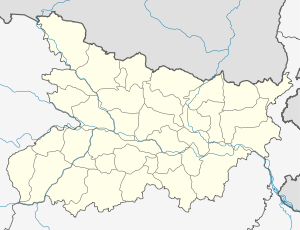Jajuara
| Yajuar | |
|---|---|
| village | |
 Yajuar Location in Bihar, India  Yajuar Yajuar (India) | |
| Coordinates: 26°18′17″N 85°40′7″E / 26.30472°N 85.66861°ECoordinates: 26°18′17″N 85°40′7″E / 26.30472°N 85.66861°E | |
| Country |
|
| State | Bihar |
| District | Muzaffarpur District |
| Area[1] | |
| • Total | 18.76 km2 (7.24 sq mi) |
| Elevation | 55 m (180 ft) |
| Population (2017) | |
| • Total | 85,875 |
| • Density | 4,600/km2 (12,000/sq mi) |
| Languages | |
| • Official | Maithili, Hindi |
| Time zone | UTC+5:30 (IST) |
| PIN | 843360 |
| ISO 3166 code | IN-BR |
| Nearest city | Darbhanga, Muzaffarpur,Sitamarhi, |
| Sex ratio | 904 ♂/♀ |
| Lok Sabha constituency | Muzaffarpur |
| Vidhan Sabha constituency | Aurai |
Jajuara, also written Jajuar and Yajuar, is the largest village in the Muzaffarpur district of Bihar in India, and the second-largest village in Bihar.
Etymology
The original name Yajuar comes from Yajur vedasaya agara yasya Yajuara, which means "Village of people who know Yajurveda one of the Veda".
Geography and climate
The Yajuar region is situated in the district of Muzaffarpur in Bihar, India. The village covers 1,876 hectares (18.76 km2), the largest village in Katra block.[1] It is 55 km (34 mi) from Muzaffarpur, and 51.2 km (31.8 mi) from Darbhanga. There is no easy way to reach its district Muzaffarpur during rainy season. The village lacks electricity and depends on kerosene oil and lanterns. In recent times, solar energy has become very popular.
The climate is mainly dry and cool. In summer the temperature varies from 35 °C (95 °F) to 45 °C (113 °F). In winter it is typically 5 °C (41 °F) to 15 °C (59 °F). The elevation is close to sea level. The soil is suited for agriculture, which is the main economic activity of the region.
Administration
There are three panchayats in Yajuar, namely Yajuar East, Yajuar Middle and Yajuar West Village. Jajuar is part of Katra YAJUAR VILLAGE 2nd LARGEST VILLAGE IN BIHAR STATE HIS LOCAL LANGUES IS "MAITHILI" STCD block.
Demographics
As of the 2011 Census of India the population of Jajuara was 85,875 making it the fourth-most populated village in Muzaffarpur district. The female to male ratio in the village was 904/1,000. The literacy rate in the city was about 60%, male literacy being 69% and female literacy being 50%.
Language
Since Yajuar is a part of Mithilanchal, Maithili is spoken by Maithils. Hindi is the second most common language.
Culture
The culture is very traditional. All the major Indian festivals are celebrated here.
Religious places and festivals
There are many spiritual places in Yajuar. Badi pokhra where the God of the village Shri Dihbad Baba's temple is situated under the Peepal tree. Several other temples are also situated on the bank of the Pokhar. Some of the other important religious places in the village are Bhagvati Sthan, Devnagar (near Gudri Bazar Bhira), Dhelmara Gosai, and Chaupadi Mahadev sthan, Hanuman Mandir in Panchove Tota near the high school. Devi Shakti peeth "Chamunda Mata mandir" is situated in Katra (block office) which is 8 km (5.0 mi) from Yajuar.
Yajuar celebrates a variety of festivals such as Holi, Ganesh Chaturthi, Chaurchan, Kojagari, Durga Puja, Diwali and Kali Puja, and Bhaiya Dooj or better known as Bhardutiya among others. The Chhath Puja of Yajuar is very famous among all the nearby villages. In Durga Puja as well as Kali Puja, a group of people commonly known as the orchestra are invited by the committee members to entertain the people with their dancing and singing acts. Durga Puja is celebrated in the premises of the Bari Pokhra temple while Kali Puja is celebrated in Harijan school.
Economy
Agriculture is the main economic activity of this village. The main crops are rice, wheat, pulses, moong, urad, arhar, jute (with a recent decline in its production), and maize.
Apart from these, yajuar also produces many fruits including mangoes. Although, mango trees can be found in the whole village, there is a special place called Bhagwanpur toal where a variety of mango trees can be found. As estimated, there are more than 25,000 mango trees in Bhagwan pur toal.
The economy is not robust and the village is considered one of the poorest in India. Flooding destroys enormous amounts of crops every year. Due to the absence of industry, a weak educational infrastructure, and criminal politics, the majority of the area's youth have had to relocate for education and earnings.
There is only one regional rural bank situated here near Gobind Chauk.
Education
There are many private and government schools in village. There is one high school name Rajykiye Kirty ucch Vidaliya Yajuar and many middle schools & one college Ram Janki inter Mahavidyalaya for higher education which is situated near badi pokhar.
References
- 1 2 "District Census Handbook Muzaffarpur, part B" (PDF). Census of India. 16 June 2014. p. 246.